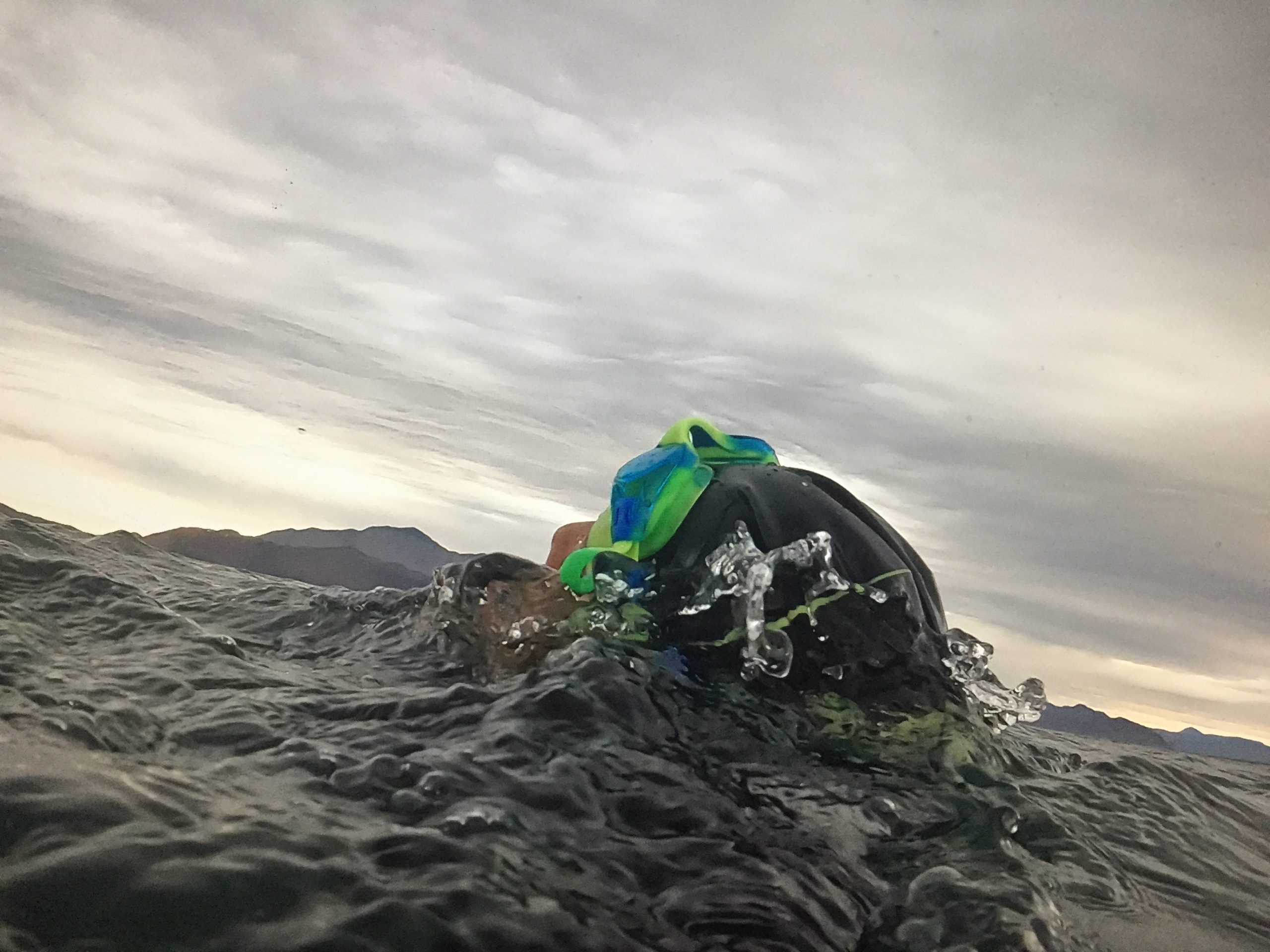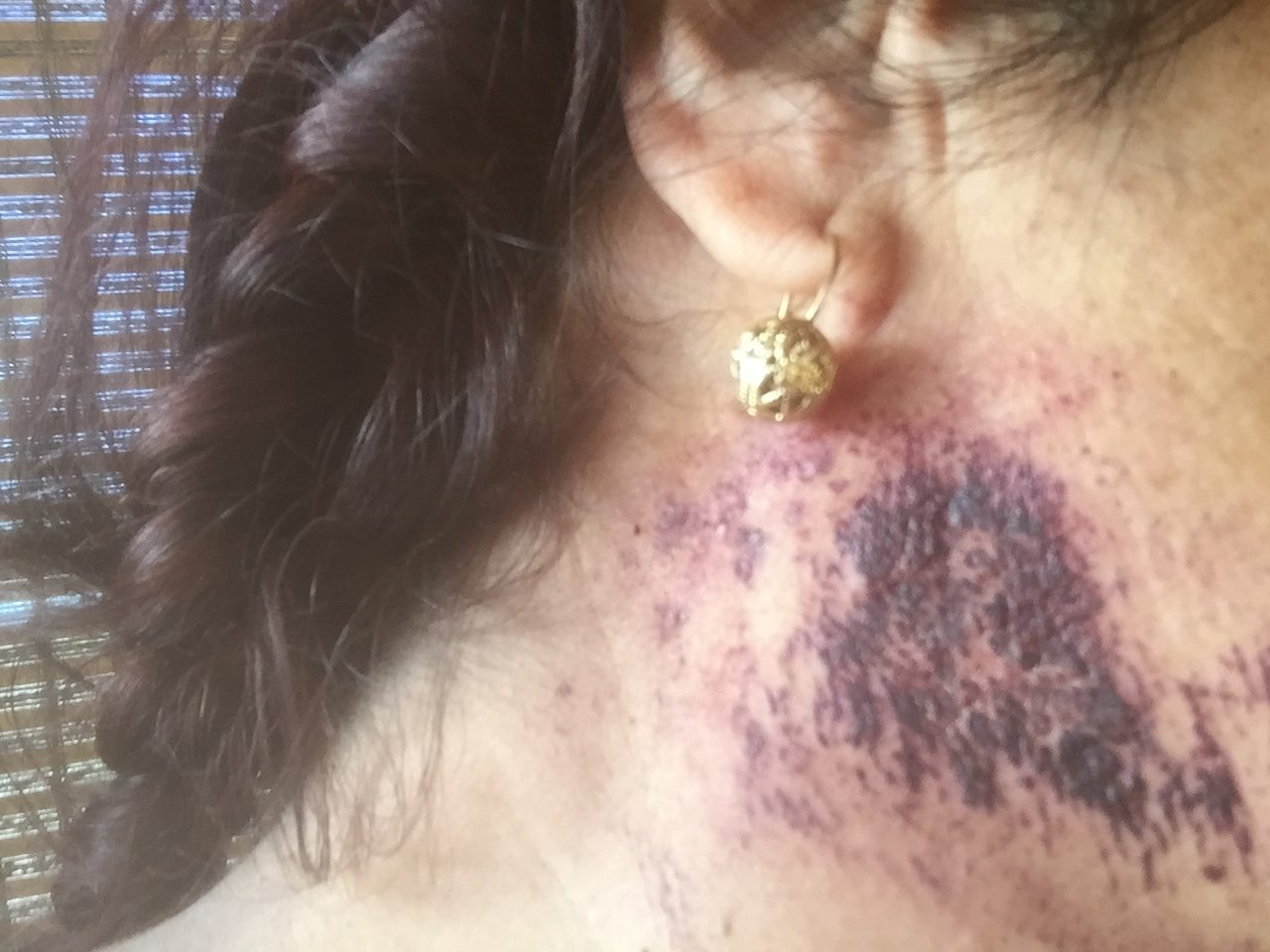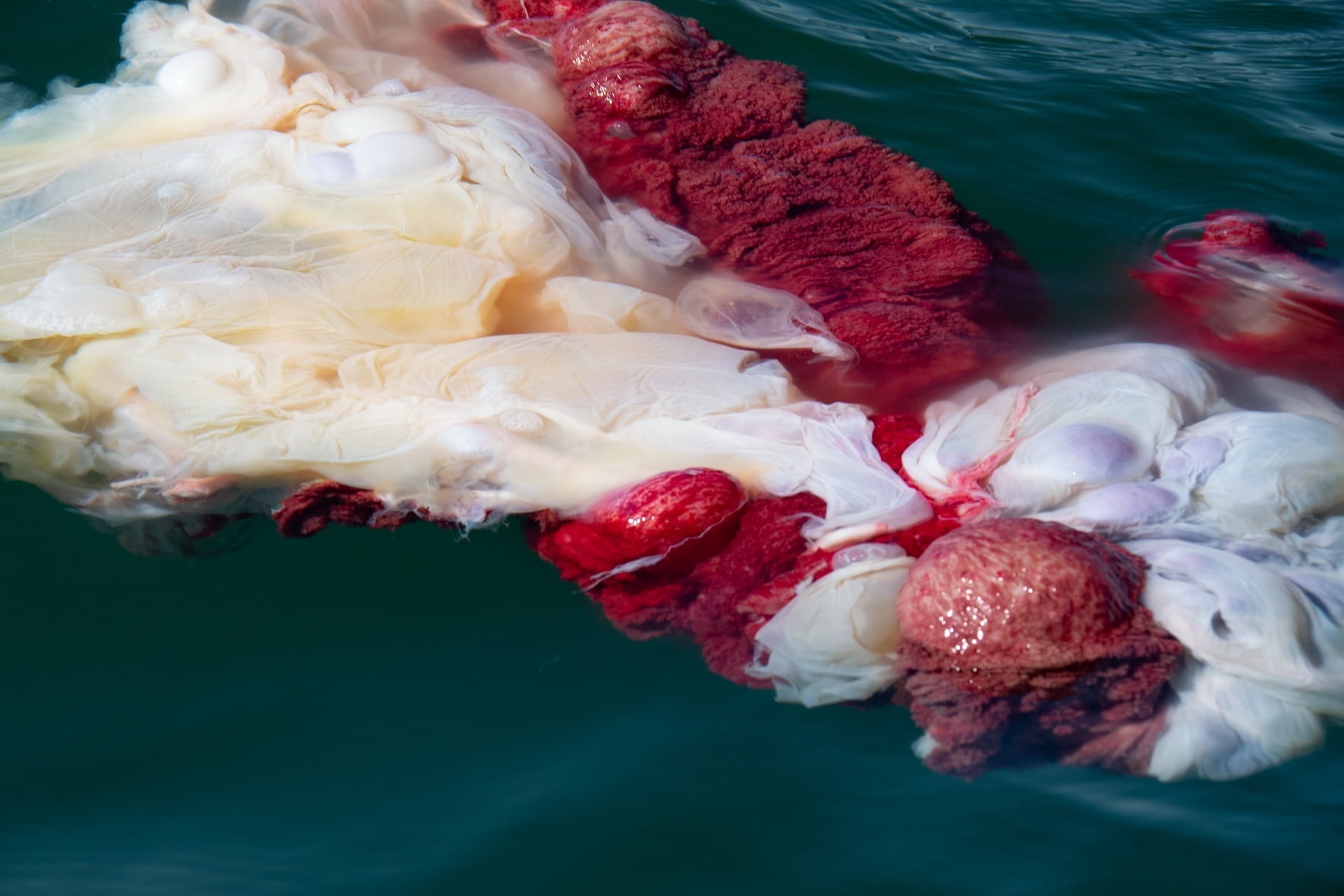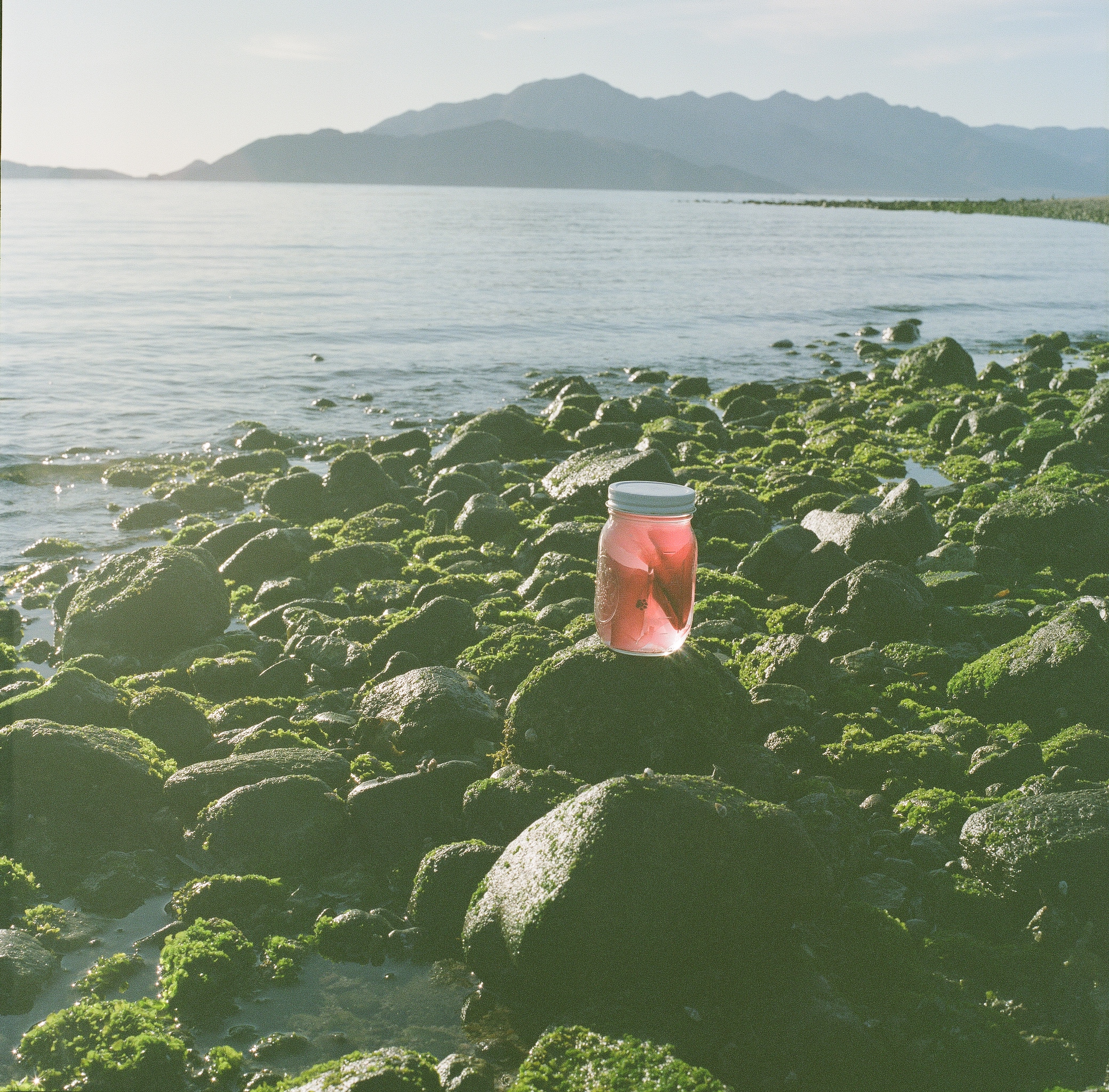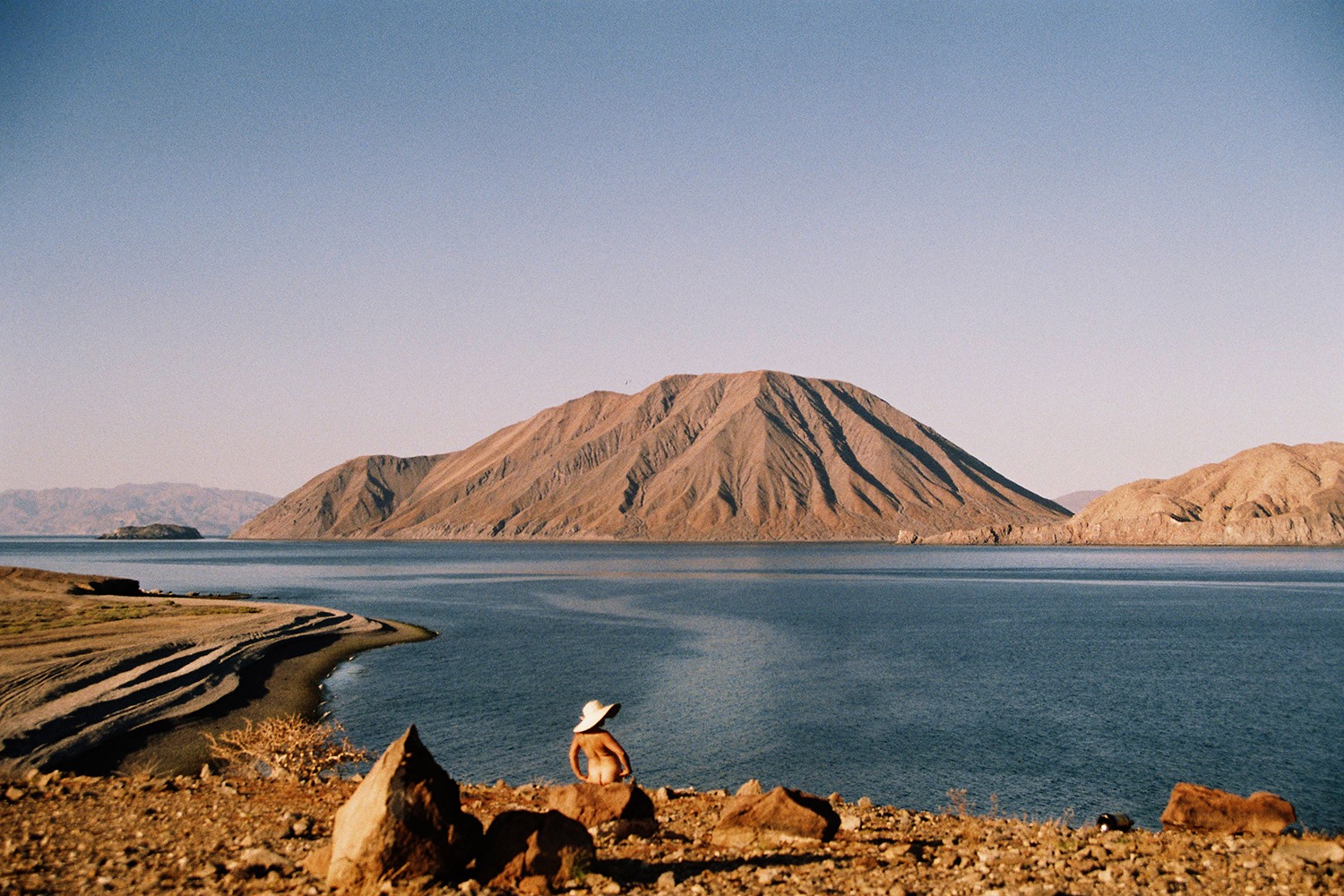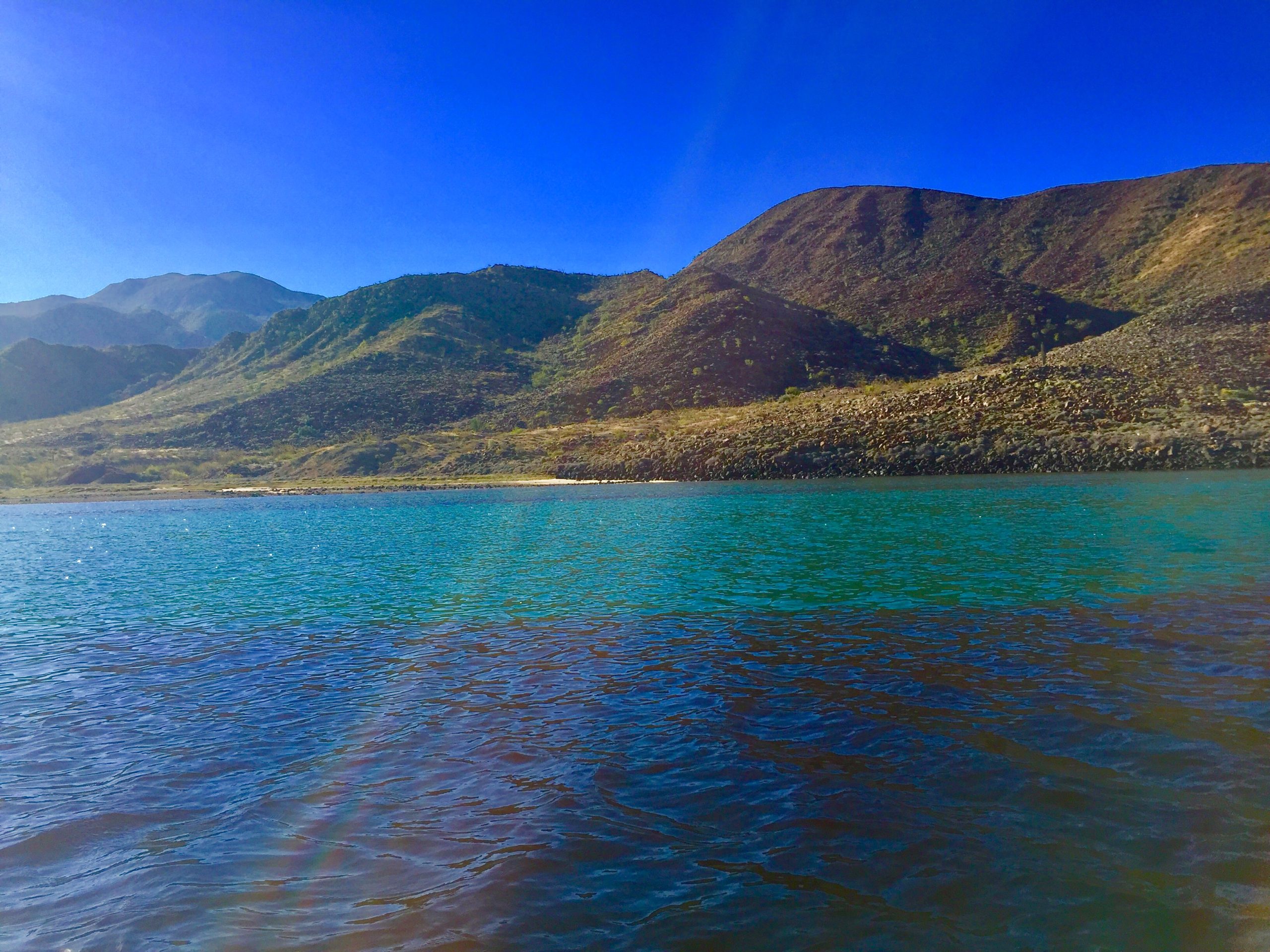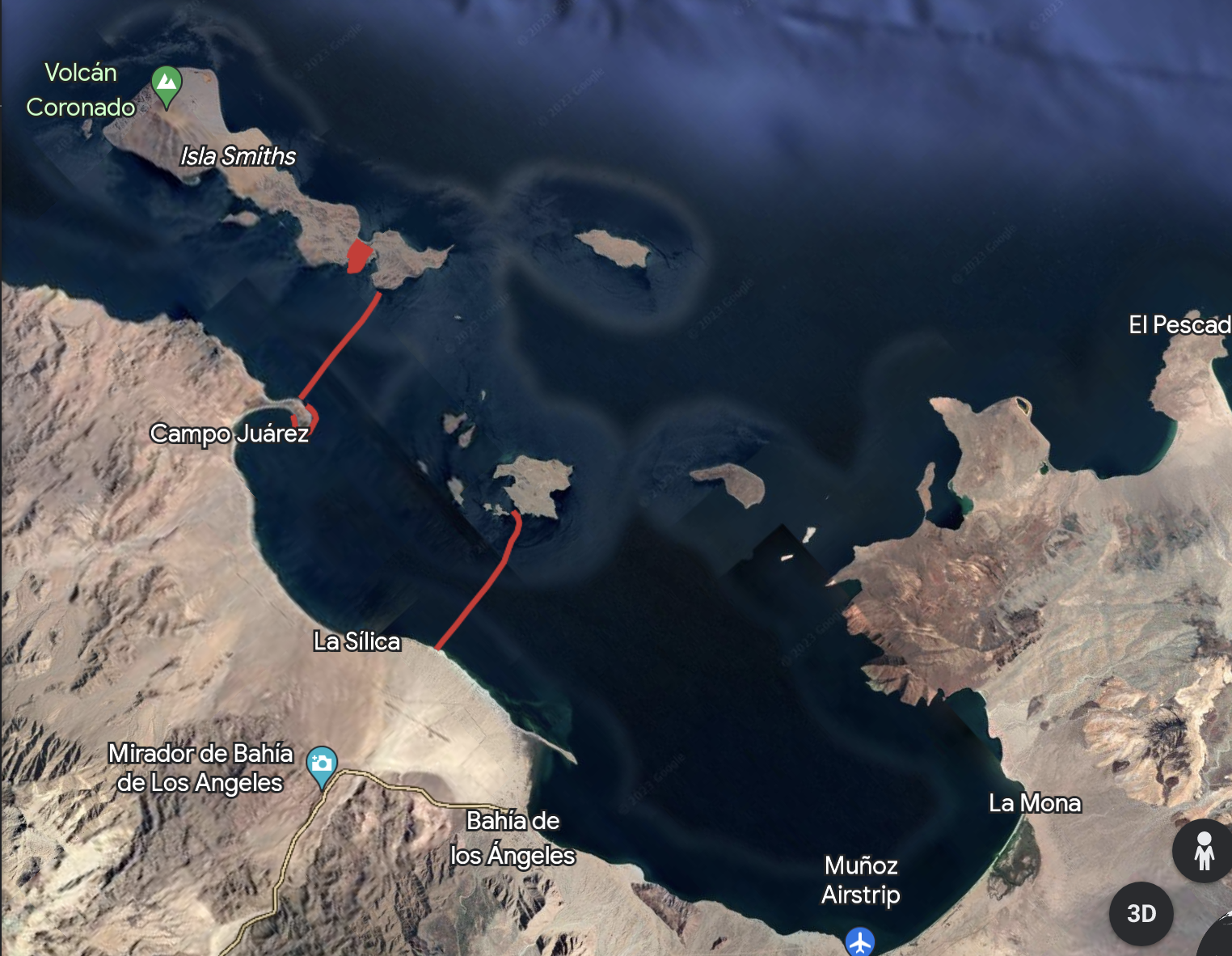OPEN SEA CROSSINGS
Whales do not travel during hurricane season
Angélica Escoto
Swimming in open waters is a brave act. It gives you a sensory acuity to dive into yourself. I experience gravity in the water. My skeleton moves in a hydrodynamic position so as not to exert force. I just must rely on my breathing and I’m aware of it. Inhale with your mouth, exhale with your nose, the opposite of on land.
I move my feet and hands, I sink my head into the sea; I exhale, bubbles come out of my nose. I see my hands pull the water, I move forward and stick my head out. I breathe with my mouth and make rhythm with my shoulders, they slide and with each stroke, with each kick, I go forward. Like this, stroke with kick, head out, kick with stroke again, head in, I am dancing. I am flying. I am breathing. I am advancing in the water, in the sea. It’s the Gulf of California, I am going towards La Ventana Island.
I trust myself. It is hard to trust. Trust how I am going to spend my energy in my body. Trust in maximum oxygen, in my aerobic capacity.
I don’t think whales travel during hurricane season. They don’t drown, they know how to swim. They know how to make their long journeys. They are not swimming in fish tanks. They are crossing the Earth’s Oceans.
What or Who do I want to think about while swimming? I ask myself a few hours before crossing the bay: my ego? my strength? my daughters and sisters? My mother who gave me birth ten times? Or think about the desert and its plants, as old as giants? I visited Las Animas Bay for the second time. I saw lomboy trees buried in white dunes, with their bare ochre roots. I saw blue herons and their legs blended in the trunks of the mangroves. I saw many dry heads of hammerhead sharks.
A year ago, in Gerrero Negro, Baja California Sur, I saw a shark called dead dog, in the old lighthouse. I didn’t know a shark with that name existed. His head is no bigger than my hand. In the village museum, they have a stuffed one, and another one named mamón shark. It’s true. You have to visit the museum; you’ll see them there. No kidding. The whale shark is as big as it is slow. He doesn’t like humans as food. Out of ten people I’ve told them about my new discipline in open waters, eight have asked me if I am not afraid of sharks. I answer them with my unabashed, nervous laugh: No.
I don’t know if I’ll be able to sleep tonight. I experience the fear and delight of living, although I accept that I am afraid of sharks. Fear of being swallowed by an orca. Fear that I can get entangled in a whale’s placenta. Fear that a current will take me to the open sea. Fear of jellyfish.
Fear is one of humanity’s oldest and most powerful emotions. Although the unknown has been reduced over time, primitive fear lives in our nervous tissues. It runs through our blood. Swimming in the sea is uncertain. The danger is real, and even more otherness is an animal.
It sounds dramatic but I mark it: swimming is an act of balance and strength on the edge of the abyss. What would be the most monstrous fear in moving my body through the sea? I have created a route to cross from island to island at Bahia de los Angeles, this is the largest archipelago in the Gulf of California. That’s how I want to grow old, swimming from island to island, and then from land to island, and then vice versa.
Faith does not move mountains but islands. I have a mental picture, an imaginary. A performative landscape. I let go of my body, I detach my mind of my body. I deliberately want to float in the ocean.
I walked for more than three hours along the seashore in front of Coronado volcano looking for the skeleton of a blue whale. I found a triangular sculpture, a pyramid made of stones. Don Rafa, the most daring and oldest boatman in the bay, doesn’t know who built them. He says they have always been there. On a pumice beach, there is the whale’s dehydrated stomach, looking like a lunar path. The stones float in the sea, and I always find them swimming. Also, hundreds of dragonflies passed by. I researched that they migrate thousands of kilometers just like whales. They are primitive beings, without skeletons. They reached the state of a molecule on Earth for the first time and became these insects that fly through water and over land.
Third Crossing: La Ventana Island, San Lorenzo Archipelago
I see it every day from my kitchen window. Google Earth tells me it’s three kilometers. This island has a cape and at the top lives an osprey. Because they are neighbors to Cerrojo Island and Llave Island, they make a small lagoon. It’s a wonderful place. I have visited them by kayak four times. A year ago, my friend Gerardo and I went all the way around, but now it’s the first time I’ve reached them by swimming. It squeezes me to know that this group of islands have the semantics of the intimacy of a house: La Ventana, La Llave, and El Cerrojo.
It smells like plankton. There is a red tide, it looks like a bleeding sea. In the village they say that if you drink it, you can get diarrhea. That is why Jacques-Yves Cousteau named the Sea of Russet, the Sea of Cortez, because when he explored the Gulf of California in his plane called Calypso, he could see large patches of plankton floating like islands.
Through the window I see a red river coming that sticks to the seashore. It advances to the end of the bay, now it is in front of the house. It groups together to stay alive longer. Like whales, these microorganisms migrate, but in very short periods of time. Their movements are associated with gravity, day and night. To balance the times of geology and its tiny mutations, they do not live more than four hours. If this were not the case in a week, its reproduction could form a sphere of equal volume to that of Earth. They move by swimming weakly in greater numbers through the seas of cold regions. That’s why they, the whales, stay close to the Poles.
Plankton means wanderer or wandering. I’ve swum inside those pink islands. With dense, sticky water. It pursues you even if you run away from it. When I cross those islands of plankton I do it with fear. Sometimes, I have been brushed by jellyfish polyps. They burn like a blowtorch and give a painful itch much more intense than that of a gnat.
I climbed with Francisco to the first hill that forms the mountains range that protects the town of Bahía de Los Angeles. There is a sidewalk behind don Ramon’s house, Francisco’s father. We start along the route to the old mines. They say that the minerals were brought down there on mules. It is a spectacular sight to see the entire bay from here and even more so when it’s colored red.
A few months ago, the tide brought me a pink spot to the shore. I captured a sample that I later left forgotten on the porch table. In the middle of the night thirst made me go to the kitchen for water and the sea was electrified. Yes, that pink spot was phytoplankton and since the night was unique and dark I could admire a phenomenon of bioluminescence. I immediately ran to see my sample. I shook it madly and a milky way appeared inside the jar. By dawn, that matter was dead, stuck to the bottom of the container. There were some shiny green and phosphorescent remains; others were black as rotten leaves. I opened it as its smell was three times stronger than a low tide.
That is why Jacques-Yves Cousteau named the Sea of Cortes, because when he was exploring the Gulf of California in his plane called Calypso, he could see large patches of plankton floating of plankton floating like island.
Dopamine and ominous. I write to distract myself. One, control your breathing. Two, acclimatize your body and face. Three, stay calm, breathe, move forward, breathe, connect you’re your surroundings. Four, stay calm and feel supported by your team on the boat. Five, ask for permission to perform (I think this should be the first point)…
It is enough to feel more doses of dopamine and trivialize ominous thoughts to not contradict myself and accomplish this journey in the sea. Even if I feel butterflies in my stomach. The emotional centers of the brain and nerves around the stomach have been evolving longer than language, so I must reflect on my intuition. In the past we needed dopamine to survive, to be better. Now, we want to release that neurotransmitter effortlessly and with an immediate reward.
Now, I’ve put the seaweed in jars. I want to record its decomposition process. Its extravagant shapes, its strange and exotic colors: ochre, brick red, slat green, amber, and mustard yellow. Its consistency looks like gelatin in the sea and its texture when dried is like rice paper. The figures are strange, some look like brains. They are unicellular and multicellular organisms. They are born in the stones where light reaches and there is little depth, here photosynthesis takes place. Its sargassum is used for crabs to spawn. Last November crabs were not there. That means that between December and March they began to be born on the stones and have a symbiosis with fish and corals. I know this because I touched one and it shrank scared and slippery. I would love to record the sound of its rhythm with choppy tide or calm tide.
Now, I’ve put the seaweed in jars. I want to record its composition process. Its extravagant shapes, its strange and exotic colors: ochre, brick red, slat green, amber and mustard yellow.
Navigation route
Google Earth Satellite Image
The San Lorenzo Archipelago National Marine Park and Reserve, located in the Gulf of California, BC, is made up of Bahía de los Ángeles, Salsipuestas channel, Ballenas channel and Las Ánimas bay. The Ballenas Channel is a large canyon where the San Andrés tectonic fault is born.
Email Me
angelicaescoto67@gmail.com

